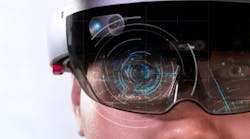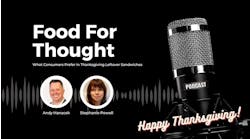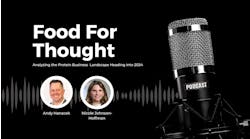On today’s episode, we’re talking Taqtile’s Kelly Malone about the realities of mixed reality. Mixed reality is a term that applies to both Augmented Reality and Virtual Reality; and while AR and VR are not necessarily new, how manufacturers are able to use these tools on their plant floor is.
During this episode, we’re talking about how manufacturers are able to use mixed reality to train their frontline workers, enhance productivity, improve inspections, onboard new employees, and much more.
Transcript
Erin: Really excited about what we're gonna talk about today. So, really easy question was right out of the gate. Can you walk us through what or who Taqtile is?
This Week's Sponsor: Yamato
Yamato is celebrating over 100 years of weighing. Yamato Corporation’s team of experts integrate automatic weighing and filling solutions into food processing facilities throughout North, Central, and South America. Find your next weighing and filling solution at YamatoAmericas.com
Kelly: Absolutely. Taqtile is a software developer, commonly known as an independent software vendor. We create applications and solutions that target and aid frontline workers. If you think about those of us that are desk jockeys, we've had productivity tools in front of us for, you know, over 30 years now, those Microsoft Office tools, email, things like that. And our frontline workers really haven't had access to those types of digital productivity tools. But now with the advent of things like spatial computing, mobile devices, you know, ubiquitous data connectivity, things like 5G, we're now able to bring that digital productivity capability to frontline workers. And so that's what we focus on.
Erin: One of the products that Taqtile has is its Manifest platform. Can you explain a bit about what Manifest is and how companies have been using it?
Kelly: Manifest is our flagship product and its used to do a few things really well. The first is capturing step-by-step work instructions. And we capture those from subject matter experts. And when we're talking about subject matter experts, we're talking about the workers who know how to operate, maintain, repair the infrastructure and the machinery within the organizations that they work within, and the processes associated with that. It doesn't require specialists like people who know 3D CAD or programming. And so, in that way, we're able to capture step-by-step instructions. They can include pictures and videos but more interestingly, they can also include spatial indicators overlaying, you know, 3D digital ink or pointers within the real-world environment over the top of that real piece of equipment or in the classroom over the top of what we would refer to as a digital twin of that equipment.
That data is then made available to other folks within the organization, operators and trainees who can then follow those step-by-step instructions. So that content then, not only was captured and organized and structured, but now it's made available to other, let's say, lower-skilled or unskilled workers or perhaps they're skilled workers but they just don't perform those procedures as often. They now have access to that content and they can review and follow that content. And then they can apply that content. And as they apply the content, they aren't just following the step-by-step instructions. They can also create content. They can do things like add evidence. If you think about an inspection, for example, which is a step-by-step procedure to, let's say, check a manufacturing line between shifts, not only can they follow the instructions for checking that manufacturing line, but they can leave evidence. They can take pictures. They can flag fault.
They can identify evidence that would then kick off another business process to perhaps do routine maintenance or break/fix repair as an example. In addition to the platform being able to work with these stored work instructions, the platform also includes the ability to dial out for assistance. So, connect with a live remote expert that can see through the eyes of the operator as they're working and interact with their environment and help them overcome a problem or troubleshoot an issue if the step-by-step instruction doesn't cover that. So, the platform includes those capabilities. It also has the ability to display live data, what we would say is like Internet of Things data or sensor data, for example.
That operator can view information about that machine, whether it's on what its RPMs are, pressure, temperature, etc. And they can visualize that in their heads-up display. And we can even create rules around those metrics, those meters if they are outside of acceptable parameters. And so, if the temperature is too hot or the pressure is too high, the operator will see an alert, and then they won't be able to proceed with a step-by-step procedure because it's unsafe until they rectify that issue and then they're able to move on.
Erin: Our audience is primarily manufacturers. Can you walk me through how some of the manufacturers and/or manufacturing organizations you partner with have been using the Manifest platform?
Kelly: Certainly. There are a number of great use cases that manufacturers are using. I just mentioned one, actually. We have a manufacturer who uses the platform to perform inspections. They inspect the line in-between shifts. That's a very common use case that the platform is well suited for.
Let’s take a step back and look at folks who are using it for training. We have a manufacturer in the Midwest, who is using Manifest for onboarding. And they've been able to take what was traditionally three weeks of classroom training with new hires, and they've been able to reduce that down to three days. They put them in the classroom for three days and then with the Manifest mixed reality work instructions, they're able to put them out on the plant floor and they can become familiar with the equipment and learn how to operate the equipment and learn specific manufacturing processes using the tool.
That training both in the classroom but then on the job is really critical. And that's one of the key use cases. Of course, then the inspections, as I mentioned, but also the operations of performing routine maintenance on a piece of equipment. So, following the step-by-step guidance to perform that routine maintenance that's required. And also, as I mentioned, the live remote assistance. So calling that to that expert. Some manufacturers are even embedding Manifest into the products that they're selling downstream to their clients.
We have equipment manufacturers that sell their equipment to other manufacturers or other clients. And instead of just sending the document of the owner's manual and operating instructions, they're also providing the augmented work instructions as part of that solution. And they're even extending their services capability so they can provide live remote assist in a mixed reality environment to that end customer as a premium offering.
Erin: I want touch upon the workforce training element for a bit because it sounds like, and I know from checking out the Taqtile website and the great stuff you guys are doing, augmented reality training for the workforce. I'm fascinated with this. Why do you think or, in your opinion, why has it become such a necessity?
Kelly: I think there are a few trends, a few elements that are really driving this. One is something that is commonly referred to as the silver tsunami. The Baby Boomers as a generation are well into retirement age. And so, a lot of our skilled workforce is actually retiring. And as they are retiring, they're taking that knowledge and understanding and that expertise of how the infrastructure and how the equipment and processes are done. And then they're just basically taking the institutional knowledge with them. So, we have that challenge.
At the same time, the work environment is getting increasingly complex. We're adding more sensors. We're automating more. That work environment's also becoming more digitized in many ways.
Then we have the challenge of the incoming workforce. One, they're not necessarily coming into the jobs as skilled in let's say, core, frontline skills are in the trades. So, there are fewer folks coming out of trade schools. And so, therefore, they don't necessarily have those trade skills. However, these incoming workers are digital natives and they do have an expectation in terms of certain digital tools being made available, and they have a certain affinity for using digital tools.
Another factor for the incoming workforce, though, that's important to note is that they're not coming in at the same rate as folks are retiring, and they're not staying in their jobs as long as they used to. Their tenure is shorter. And this puts a lot of pressure on an organization to both maintain their level of productivity, but at the same time, onboard new employees in an efficient way. And so, this is one area where mixed reality or augmented reality really can help out because it becomes a force multiplier. That organization that now, you know, has fewer experts to rely upon to train the incoming workforce, can now utilize mixed reality as the tool to help onboard and train those folks. And that expert can then stay more productive or they can train many more...they can support many more trainees at the same time, in bringing that lower-skilled or under-skilled workforce up to speed.
Erin: How has COVID-19 impacted the adoption of this kind of technology?
Kelly: As you know, with COVID-19, people stopped traveling is one; we weren't permitted to travel. That was one key area that accelerated the adoption of this technology because when a piece of equipment would break down or an issue needed to be dealt with, historically, the technicians would get on an airplane, they would fly to the destination and those experts would then perform the work in-person. Using mixed reality, especially with the remote assistance, the remote experts' capabilities, now they're able to stay in one place operating on a device that they have at hand, let's say that's a PC or could be a tablet, and they can reach out to an operator that's at the equipment that may not have their same level of skill, but they can still work through that individual to troubleshoot and to resolve problems because with that person at the piece of equipment, having a mixed reality enabled device in hand, whether that's a head-mounted device or a tablet, they can guide that worker so they can assess the situation and then they can guide that worker towards the resolution.
Very similarly, also social distancing required that fewer people were permitted into the office or onto the plant floor. And again, this remote expert capability permitted folks to support operators remotely from, you know, even travel wasn't required just from their home offices to support the folks who were on the shop floor, if you will. Add on to that the ability to follow step-by-step, you know, stored work instructions. That also reduced the need to have that second supervisor or observer available because that operator had the assistance that they needed to get through a complex task or procedure.
Erin: Using AR or mixed reality for training may seem a little cutting edge for some. For an organization that's maybe slower to adopt this kind of technology, and we all know that there are some, what are some of the selling points to help them understand the relevance?
Kelly: That's a good question. And one, I think that it's a bit of a misnomer to think that, you know, this augmented reality or mixed reality is bleeding edge. It's actually been around for a while and we're now into the third generation of mixed reality headset devices. We're even further down the road in terms of mobile and tablet devices. And so, I think from a device perspective, the space is maturing. Any technology – a gadget if you will – over time, will get smaller and more capable. We do expect to see that happen as time goes on where these devices will get smaller and more comfortable. But that said, the devices that we have today are extremely capable. And we are deploying them into operational use with great results today. I think it's important for folks to understand that. That said, it's also important to emphasize the fact that this capability is available on devices that people already have in hand today. You can operate these solutions in a browser running on your PC or on the mobile devices and the tablet devices that we're already carrying around within the workplace. I think that's another critical area to focus on is that you don't have to start with the most sophisticated head-mounted devices, you can actually start on the mobile device.
Erin: Who is it that's doing the contacting and setting up the demos between the manufacturers and your teams? Is it HR departments, plant floor managers?
Kelly: Typically, it's no one group that's driving it. I would say a couple of years ago, it was the innovation team within IT that was really kind of driving a lot of this. We still have some of that, where the IT group is looking at their digital transformation objectives and how can they apply augmented reality, virtual reality, immersive technologies to assist. We are seeing now that business operational leaders also look to this technology because they have such a need to get their staff either trained on an ongoing basis, up to speed, but also just continual enhancement and improvement of operations. We see a lot of folks at the operational level assistant plant managers, plant managers having interest in this technology.
We're also being brought in, interestingly enough, in many cases on the investment side. We've been brought in private equity firms into their portfolio, for example. So, they've seen something successful in one business that's within their portfolio. And now they wanna introduce this technology across other organizations within their portfolio to replicate that success. And so, I think that we're seeing both bottoms-up adoption, as well as top-down adoption.
Erin: If a manufacturer were considering going this route and wanted to get in touch or learn more, how could they go about doing so?
Kelly: Well, of course, they can go to our website to get more information. Feel free to reach out to me directly and I'd be happy to either answer your inquiries directly or refer you to somebody in our organization that can help you out


